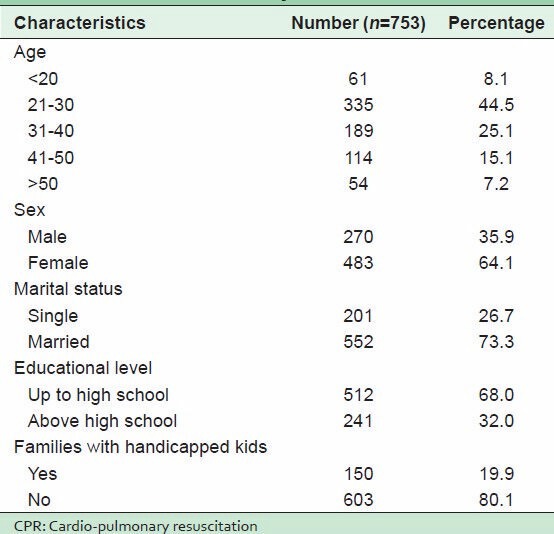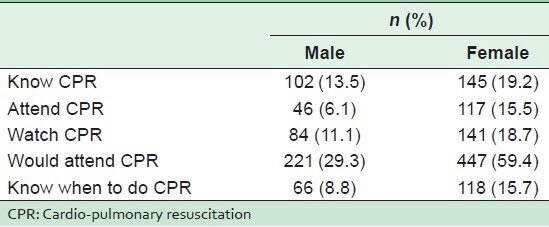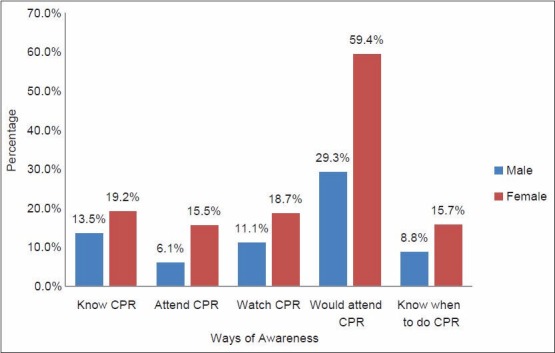Abstract
Background:
The history of resuscitation going back thousands of years has been reported in literature throughout history. This concept has undergone several decisive revolutionary changes particularly in pediatrics. Although the cardio-pulmonary resuscitation (CPR) is relatively new in pediatrics, progress has been remarkable in the last a few decades. As it becomes more popular, especially under the influence of globalizing media, CPR also becomes a life requirement that is not restricted to health professionals.
Materials and Methods:
This was a cross-sectional community-based survey of 753 individuals of both sexes, visiting the first Pediatric Health Awareness Week held at Dammam University Hospital in April 2013. Data were collected by a personal face-to-face interview during which a short history was taken and a check list of sociodemographic data and questions related to infants' CPR was completed. Statistical analysis was performed by using SPSS.
Results:
The study was carried out on 753 subjects (602 Saudis, 151 non-Saudis, 483 females, and 270 males). The mean age of participants was 33.3 ± 10.9 years. The postsecondary school level of education was 37.5% among females versus 21.9% among males. Of the participants, 80.8% of the females and 86.5% of males were totally unaware of CPR. The mean number of children among participants was 3.5 ± 2.5 children. There were 150 participants (19.9%) with disabled children; 32% of them (6.4% of all participants) were completely unaware of CPR despite having disabled children. Overall, 15.5% of all female participants had attended some CPR course (s) compared with 6.1% of the males; 18.7% of the females had watched CPR program (s)/video (s) on TV or online compared to 11.1% of the males, and 59.4% of the females were willing and eager to participate in any CPR course compared with 29.3% of the males. The reasons for not wanting to attend CPR courses were as follows: 48.6% indicated that it was because of the unavailability of such courses, 41.4% said because of time constraints, and 10% gave financial reasons. Finally, the study showed that 365 females (84.3%) and 247 males (91.2%) did not know when to perform mouth-to-mouth resuscitation and/or chest compression, and would do it for the wrong reasons.
Conclusion:
Public awareness and knowledge on CPR was inadequate even among the younger population, and among parents with disabled children. The general public were willing to improve their knowledge and skills of CPR. We recommend that CPR courses/campaigns should be provided to the public and be included in high school curricula.
Keywords: Awareness, cardio-pulmonary resuscitation, handicap, infant
INTRODUCTION
Cardio-pulmonary resuscitation (CPR) has become a life requirement, the use of which is no longer limited to health care professionals. According to last Ministry of Health statistics, more than one-third of the Saudi society is made up of children. This means that the public has to learn first aid especially pediatric resuscitation. It is well known that children aged 1-5 years form the age group most affected by accidents, which puts them at the high end of the risk of morbidity and mortality. Therefore, it is important to study the public awareness and knowledge of CPR. Moreover, to the best of our knowledge, no national study has focused on this particular issue. This article will present, discuss and analyze public awareness and knowledge of pediatric CPR in Al-Khobar city.
MATERIALS AND METHODS
This was a cross-sectional community-based survey of individuals of both sexes, visiting the 1st Pediatric Health Awareness Week (PHAW) held at Dammam University Hospital in April 2013. The PHAW activity was a public health educational campaign covering a period of a week designed by the Department of Pediatrics of the largest government, and the only University Hospital in the region where thousands of people (of different educational, economic, ethnic backgrounds) present every day. The campaign had multiple educational booths where there was interaction with visitors who were also provided with the required information in all pediatric sub-specialties. One of the booths was designed to promote public knowledge of pediatric CPR, brochures, video clips and manikins were used to achieve this goal. The study was of 753 subjects. Data were collected by personal face-to-face interviews, during which a short history was taken and the check list of sociodemographic data and questions related to infants' CPR was completed. The obtained data were recorded on a standard survey sheet prepared specifically for this study. SPSS version 16, used for statistical analysis.
RESULTS
This study [Table 1] was carried out on 753 subjects 602 Saudis, 151 non-Saudis, 483 females (354 married vs. 129 single), and 270 males (198 married vs. 72 single). The mean age of females was 32.4 ± 10.3 years and for males it was 35.0 ± 11.9 years; (total participants' age was 33.3 ± 10.9 years, and 37.1 ± 9.8 years for married participants). Females with postsecondary school level of education was 37.5% in contrast to 21.9% of males (total of 241 participants, 32.0%); none of the participants were illiterate. Of all the participants, 80.8% of the females and 86.5% males were completely unaware of CPR. The mean number of children of the married females was 3.5 ± 2.2 children versus 3.7 ± 2.9 children of the married males (average 3.5 ± 2.5).
Table 1.
Characteristics of participants who enrolled in the CPR study

Ninety-nine married females had disabled child/children; 39 mothers of these children were completely unaware of CPR. On the other hand, 51 married males had disabled child/children, and 9 of these fathers were totally unaware of CPR. In other words, 150 families (19.9%) among the participants had disabled children. Of this number 32% (6.4% of all participants) were completely unaware of CPR despite having disabled children. The survey [Table 2] also showed that 15.5% of all female participants had attended CPR course (s) compared with 6.1% of the males (21.6% of all participants); 18.7% of the females had watched CPR program (s)/video (s) on TV or online compared to 11.1% males (29.8% of all participants); and 59.4% of the females were willing and eager to attend CPR courses whenever available compared with 29.3% males (88.7% of all participants) who were interested [Figure 1]. The reasons for not wanting to attend CPR courses were as follows: 48.6% gave reasons of unavailability of such courses, 41.4% said the designated times were not suitable, and 10% gave financial reasons [Table 3].
Table 2.
Population's awareness of CPR

Figure 1.

Population awareness of cardio-pulmonary resuscitation
Table 3.
Reasons for not attending CPR courses

Finally, the study showed that 365 females (84.3%) and 247 males (91.2%) did not know when to perform mouth-to-mouth resuscitation and/or chest compression, which they would do for totally wrong reasons. All participants (100%) emphasized that educating public on CPR was vital and the information they had received during the campaign was beneficial, practical and easy to apply.
DISCUSSION
The inversion method (where the patient is hung by the feet and pressure applied to the chest for respiration) was described by old Egyptians more than 3500 years ago. In 1740, the Paris Academy of Sciences officially recommended mouth-to-mouth resuscitation for victims of drowning in the early 20th century, CPR underwent several changes taking it to a totally different level of advancement. However, it wasn't until 1983 that the American Heart Association convened a national conference on pediatric resuscitation to develop CPR and Emergency Cardiovascular Care Guidelines for pediatric and neonatal patients. Since then, several guidelines have been produced and revised. In 2010, the latest CPR guidelines were released on the 50th anniversary of CPR.
Despite this rapid progress in CPR and its programs, public awareness of its importance is minimal particularly when it comes to children. Several studies have discussed public awareness, knowledge and attitude regarding adult CPR. However, to our knowledge, no study has focused on public awareness of infant CPR. Utilizing social gatherings to educate and implement the concepts of CPR is highly recommended and has beneficial results.[1,2] Continuity of these programs is equally important since it has been reported that even the trained subjects are likely to forget information and lose skills.[3] Training the public is important for the attainment of positive outcomes especially in situations where it is difficult for professionals to be physically present at the right time.[4] We expected our society to have an unsatisfactory knowledge of very basic CPR information as had been found in other societies.[5] The importance of ensuring that the public acquires both knowledge and skills of CPR is crucial to decreasing out-of-hospital mortality.[6] Thus, public opinion supports the establishment of societal consensus on resuscitation preferences, which may be useful in the development of local guidelines and policies.[7]
This study has shown that out of the 753 participants, 506 subjects (67.2%) were totally unaware of CPR (80.8% females and 86.5% males). It was not a surprise that two-thirds of the people were unaware of CPR since several studies have alluded to the inadequate public knowledge of CPR.[5,6,7]
Although studies have shown that older people were usually those less likely to know about CPR,[8] our study showed that our sample age which was much younger also had inadequate knowledge. The mean age of females was 32.4 ± 10.3 years and 35.0 ± 11.9 years for males (total participants age: 33.3 ± 10.9 years, and 37.1 ± 9.8 years for married participants). The total number of married participants (both males and females) was 552 subjects (73.3%); 36 participants (4.8%) were married but with no children. The mean number of children per remaining married participants was 3.5 ± 2.5 children. The intension of this study was to classify participants on the basis of both marital status and the number of children they had with the aim of studying the prevalence of children with disability in the community and the relation between having a disabled child and the family's knowledge and awareness of CPR. The prevalence of disability in the study was 19.9%. 150 participants (99 females and 51 males) had at least one disabled child at home. Forty-eight of these parents (32%) (39 mothers and 9 fathers) were unaware of CPR though they had at least one child with disability (6.4% of all participants). We could not compare this finding to any published report since, to our knowledge, no study had done a comparison of the family's awareness of CPR when there was a child with disability in the family. It was also noticed that males were more aware of CPR, but females were more motivated to improving their knowledge of CPR.
However, CPR-knowledge of both genders was deficient. Of the participants, 117 females (15.5%) had attended CPR course (s) compared to 46 males (6.1%); 141 females (18.7%) had watched some CPR programs/clips on TV or online compared to 84 males (11.1%), and 447 females (59.4%) were willing and eager to attend CPR courses whenever available compared to 221 males (29.3%). It is unclear whether or not these variations were related to the differences in the level of education between the genders (females and males postsecondary school level of education was 37.5% and 21.9% respectively). Studies have shown that the level of education is unlikely to have a link to CPR awareness,[9,10] which agrees with the finding of this study. The data showed that despite the differences in the levels of education, 84.3% of females and 91.2% of males were totally wrong when it came to when to perform mouth-to-mouth resuscitation and/or chest compression.
Although the vast majority of the participants were motivated and eager to join CPR courses and improve their skills and knowledge, there were some constraints to the practicality of attending these courses. Almost half of the participants (48.6%) agreed that the biggest challenge was indeed the unavailability of these courses to the general public, as the courses were usually restricted to health care professionals. The other main obstacle against joining CPR courses was the constraint of time as 41.4% of the participants said. The financial burden was the last obstacle for the remaining 10%. Although the first two reasons have not been significantly reported in literature as risk factors, our result confirmed earlier published material that cost was not a barrier.[8]
Using manikins as an educative tool is a useful, successful method for demonstration, and training the public is crucial to enhancing awareness and willingness to apply CPR whenever needed.[5,11,12] Thus, all the participants (100%) in our study acknowledged the usefulness, practicality and ease of application of the information provided. All participants requested that such CPR-educative events be done on a regular and more frequent basis. One study has shown that the basic life support courses may not be useful for lay persons in the long run; and that the basic points of information for delivery to the lay community should be revised on daily basis before use.[1]
CONCLUSION
Although the level of motivation and willingness to acquire knowledge of CPR was encouraging, public awareness and knowledge on CPR was inadequate, even among the younger and educated population of community of Al-Khobar city. In addition, almost one-third of families with disabled children lacked some basic yet essential information about CPR. This particular point has to be carefully studied to find out the relation between family history of disability and overall CPR knowledge and awareness.
Despite the fact that men were found to be more aware of CPR than women, women were found to be more motivated to improving their knowledge and skills of CPR than men. However, both genders had inadequate CPR-knowledge and shared the same misconceptions, even though the women had a higher level of education. As has been reported in other studies, the level of education seemed to be unrelated to the level of knowledge of CPR. The vast majority of people were willing to be involved in CPR courses and campaigns. However, the unavailability of these events to the general public, and some scheduling issues were the most common challenges against involvement in the courses and campaigns. Our study has confirmed that cost was not an important issue among lay public. We recommend a national plan to implement CPR courses/campaigns for the public on a regular and frequent basis, and that manikins should be used in the demonstrations. We also recommend that CPR should be included in high school curricula as this could provide the much needed support for the society.
Footnotes
Source of Support: Nil
Conflict of Interest: None declared.
REFERENCES
- 1.Fong YT, Anantharaman V, Lim SH, Leong KF, Pokkan G. Mass cardiopulmonary resuscitation 99-Survey results of a multi-organisational effort in public education in cardiopulmonary resuscitation. Resuscitation. 2001;49:201–5. doi: 10.1016/s0300-9572(01)00312-4. [DOI] [PubMed] [Google Scholar]
- 2.Piepho T, Resch N, Heid F, Werner C, Noppens RR. Lay basic life support: The current situation in a medium-sized German town. Emerg Med J. 2011;28:786–9. doi: 10.1136/emj.2010.092957. [DOI] [PubMed] [Google Scholar]
- 3.Abbas A, Bukhari SI, Ahmad F. Knowledge of first aid and basic life support amongst medical students: A comparison between trained and un-trained students. J Pak Med Assoc. 2011;61:613–6. [PubMed] [Google Scholar]
- 4.Rowe BH, Shuster M, Zambon S, Wilson E, Stewart D, Nolan RP, et al. Preparation, attitudes and behaviour in nonhospital cardiac emergencies: Evaluating a community's readiness to act. Can J Cardiol. 1998;14:371–7. [PubMed] [Google Scholar]
- 5.Rajapakse R, Noè M, Kersnik J. Public knowledge of cardiopulmonary resuscitation in Republic of Slovenia. Wien Klin Wochenschr. 2010;122:667–72. doi: 10.1007/s00508-010-1489-8. [DOI] [PubMed] [Google Scholar]
- 6.Kuramoto N, Morimoto T, Kubota Y, Maeda Y, Seki S, Takada K, et al. Public perception of and willingness to perform bystander CPR in Japan. Resuscitation. 2008;79:475–81. doi: 10.1016/j.resuscitation.2008.07.005. [DOI] [PubMed] [Google Scholar]
- 7.Marco CA, Schears RM. Societal opinions regarding CPR. Am J Emerg Med. 2002;20:207–11. doi: 10.1053/ajem.2002.32626. [DOI] [PubMed] [Google Scholar]
- 8.Jennings S, Hara TO, Cavanagh B, Bennett K. A national survey of prevalence of cardiopulmonary resuscitation training and knowledge of the emergency number in Ireland. Resuscitation. 2009;80:1039–42. doi: 10.1016/j.resuscitation.2009.05.023. [DOI] [PubMed] [Google Scholar]
- 9.Mpotos N, Vekeman E, Monsieurs K, Derese A, Valcke M. Knowledge and willingness to teach cardiopulmonary resuscitation: A survey amongst 4273 teachers. Resuscitation. 2013;84:496–500. doi: 10.1016/j.resuscitation.2013.01.023. [DOI] [PubMed] [Google Scholar]
- 10.Patsaki A, Pantazopoulos I, Dontas I, Passali C, Papadimitriou L, Xanthos T. Evaluation of Greek high school teachers' knowledge in basic life support, automated external defibrillation, and foreign body airway obstruction: Implications for nursing interventions. J Emerg Nurs. 2012;38:176–81. doi: 10.1016/j.jen.2010.09.002. [DOI] [PubMed] [Google Scholar]
- 11.Corrado G, Rovelli E, Beretta S, Santarone M, Ferrari G. Cardiopulmonary resuscitation training in high-school adolescents by distributing personal manikins. The Como-Cuore experience in the area of Como, Italy. J Cardiovasc Med (Hagerstown) 2011;12:249–54. doi: 10.2459/JCM.0b013e328341027d. [DOI] [PubMed] [Google Scholar]
- 12.Lee MJ, Hwang SO, Cha KC, Cho GC, Yang HJ, Rho TH. Influence of nationwide policy on citizens' awareness and willingness to perform bystander cardiopulmonary resuscitation. Resuscitation. 2013;84:889–94. doi: 10.1016/j.resuscitation.2013.01.009. [DOI] [PubMed] [Google Scholar]


